#gloss varnish for wood
Explore tagged Tumblr posts
Text
#clear varnish for wood#wood varnish paint#cheap varnish for wood#varnish paint price#varnish#varnish paint#timber varnish#oil based varnish#varnish timber#wood varnish perth#wood paint#wood gloss varnish#wood lacquer perth#wood varnish price#wood varnish#wood gloss#interior timber varnish#interior varnish#wood lacquer#varnish paint for wood#high gloss oil varnish for wood#wooden furniture varnish#wood lacquers perth#buy wood lacquers online#gloss varnish#varnish for wood#wood varnishes perth#wood varnish gloss#gloss varnish for wood#oil varnish
0 notes
Text
sweet surrender.
bruce wayne x male reader headcanon.
summary: there's nothing better than taking your anger out on someone you hate (and fucked).
wc: 2.3k. genre: smut. warnings: bale!bruce, top!bruce, bottom!reader, bigdick!bruce, bratty!reader breeding, mouth-fucking, rough!sex, hate!sex, choking, drooling, spitting, mentions of pain slash pleasure, bruce has a dick that won't quit.
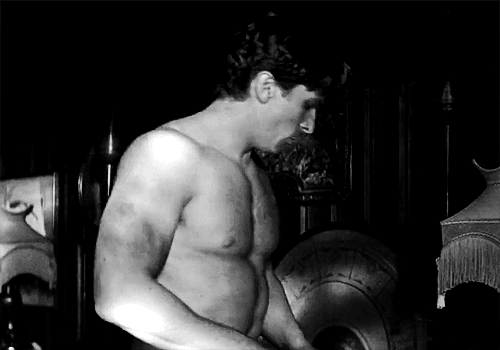

hate sex with bruce included kissing you with a sense of urgency. he overwhelmed you with the intrusion of his tongue. you resisted, but the wet muscle parted your lips so easily despite your efforts, and all you could do was fight back with a stronger force.
he held you against the wall, pinned you, but you utilized a surprising strength to push against his hold and bit down on his tongue in midst. an accidental move on your part, but you hated him. it made your chest swell hearing him cuss you out, and so you did it again, across his bottom lip where he'd groan again, before licking the insides of his mouth as if you were the potion to soothe his wounds.
fuck you. he'd grumble, breathing hot into your mouth after he slammed back into the wall. he speared a glare at you, into the fervent display of your eyes, and forced his lips back onto you. he hated kissing you. he hated the way your lips perfectly fit into his. he hated how your breath mixed sweetly with the scent of roasted coffee beans of his. he hated the sound of your moans when he pressed his body into yours. he hated the fact that he was pressing so close to you, practically attached to your hip.
and he hated the fact that there was not a single moment where he wanted to pull away.
fuck you. you spat at him, leered at the way his hair sweatily yet perfectly hung over his eyes as if it was a protective barrier that prevented you from dissecting his current feelings and emotion.
bruce vied for control—a dominance—that was proclaimed triumphant when he put his hands on you.
one strong hand of his laced over your hair, thick bundles at his grip, and he pulled your head back in one swift yank. your eyes opened in shock followed by a rattled groan, and a somewhat unnerving fear that you didn't want to admit led you to avoid his eyes.
bruce took his time eyeing your throat, the slow bob of your adam's apple as you thickly swallowed the ghost of coffee beans down, awaiting his next move. was he going to kiss you again? mark hickies all over you? bite hickies into you until you bled? looking beneath your eyelashes, his eyes sharpened, and for some reason, you suddenly felt smaller.
the silence around you fell to a quiet, menacing drone when he raised his free hand and one-by-one, slowly wrapped his fingers around your throat. everything was precise with him. he made sure the protrusion in your throat was centered at the space between his thumb and index. he made sure to let go of your hair so he could press you flat against the wall again, restricting your movements. and he made sure to squeeze, triggering a defiance in you, beating and pushing at his chest that only made him squeeze harder, harder, and harder.
your breath was vaulted in the back of your throat with staggers of profanity managing to slip out. you pretended it didn't affect you. despite your losing grasp in reality as bruce gradually stripped you of air, you powered through and wore a glare that crowned you a champion. he groaned. a warrior. he clenched his jaw. a king. he squeezed. and your crown shattered in a million pieces when your vision blurs, when your eyes gloss like varnish on wood, and when you shut them and a tear rolled down the flush of your cheeks.
and bruce knew he'd won when he let go, and you were gasping desperately for air. heaving as you rubbed at your neck, wincing because the muscle fibers were signaling in thrums that you were going to be bruising the morning after. though, it wouldn't be long until you found your breath completely stripped away from you again.
hate sex with bruce included forcing you down on your knees before finding a perfect grasp on the back of your head and pushing your mouth down his cock. you hated how thick he was, making you look even more meek because it was a struggle to even take in the first few inches. you coughed when he pushed lower, then gagged when the girth of his cock weighed down on your tongue and pushed air back down your throat, blocking your air passage.
open your mouth. he wasn't satisfied, mocking in his tone as he yanked your head back, and you'd use the few seconds to catch your breath as you drew your tongue out, hanging your mouth open. it was intimidating to see him in this position, towering over you as if you were a peasant to his kingdom, or like an animal as your pants were akin to one, but you'd never admit that as you glared upwards. he extended your head further back, yanked again, before thickly spitting into your mouth. or in bruce's own words, lubing your mouth.
as much control he had over you, you weren't going to take it—not like this. you scrunched your face before spitting up back at him, a few speckles landing at his cheek. it was a daring move, one that silenced the room until you could hear your heartbeat resonating through the stereos in his house.
do that again, i dare you. bruce warned—demanded—as his grasp only tightened, his cock hardening before you as it pulsed with anger. and instead of spitting, you let your saliva completely spill out, pushing it out in bubbly sputters as your tongue hung out, a move to mock him and his demands.
or what? going to fuck my mouth or something? despite his grip on you, it was loose enough for you to allow you to extend your neck and lick a stride at the underside of his meaty cock. he watched you in silence, his bare chest gradually heaving more with irritation. he was breathing through his nose, an obvious attempt to control the flame you ignited him, while you continued lazily tonguing at his cock at the plump head. you added to the glorious sheen his pre-cum had bestowed upon the pink flesh over time, lapping the thick musk up in several licks.
you'd get your answer when bruce threw you over the bed and onto your stomach. your cock found pleasurable refuge in the tousled duvet beneath you and you rocked your hips into the pocket of fabric as you waited for him, hearing him uncapping a bottle of some sort and the sounds of sticky lathers after.
jesus, what's taking so— without warning, bruce intruded into your tight hole with a slow, yet unbearable push. you pushed away, or attempted to escape from the sheer amount of pain beneath you, but he reeled you back by taking your shoulders and pinning them down to the mattress. it knocked the breath out of you. his cock, spreading you open so vividly painful, you could feel every stretch of muscle being pried open despite your natural will to enclose around him.
you opened your mouth, thinking your whimpers would come out, but your throat constricted instead, locking them back in until bruce delivered one hard snap of his strong hips, dispelling the gate to which your groans poured out in staggered and bitter pants. your toes curled at the stinging sensation, and your hands fisted into whatever fabric was in your had, but why did you love it? why did you love feeling like a doll with absolute no use in the world... except for fucking? for bruce's fucking?
think you can still run your mouth? bruce asked with no expectations of a coherent answer from you. he squeezed hard at every flesh and bone he'd come across. the back of your neck, your shoulders, your arms, your waist, bruising while the driving of his hips seemed to have been at competition with his own physical touch to see which could make you break first.
his hand ran over your back muscles, the dip of your spine, before traveling back upwards to shove your face into the mattress, once again restricting your way to life, to living, to breathing. his thick cock fucked into you while a glorious amount of lube creamed out of your violated hole, squelching and squishing with every thrust bruce would deliver in strong and heavy rhythms. he hated you. his bruising touch was evidence of that, already blooming beautiful against your skin, and he hated that he made the mistake of marking you because now you're marked as his.
you'd whine for him to keep fucking you, only because his movements rocked you into the duvet, making you fuck into the pocket of fabric. soft yet fuzzy against your skin, it was uncomfortable but you knew bruce wouldn't make you cum through his own touch. it was up to you, and you were selfish, needed to be selfish to achieve your own desires and pleasures.
you'd gotten used to the pain, soon turning into bittersweet, eye-rolling pleasure, finding yourself fucking your ass back into his thrusts, back into his meaty and throbbing cock. your ass rippled every time your skin met his, slapped loudly in the lust-driven air, and the sweat on your kindled bodies only made it more inviting as it stuck and glued you two together in a sticky mess, intertwined and passionate.
bruce held you by the hips, his fingers digging to the bone, bringing your ass back into him while he thrusted forward, ramming into you as hard as he could muster the power to in quick bursts before pacing back down into long and steady thrusts. he loved doing that. he loved hearing your moans ratter with the quickness of his thrusts. your long and drawn out hiss when he pulled out almost completely. you'd desperately wish for him to put it back in, and bruce wouldn't absolutely comply until you began whining, begging for him like a whore in heat.
please, please, please. i need it. you desperately cried out, the rim of your hole clinging onto for sanity—the very tip of his cock that you could feel bruce teasingly swirl around your hole.
you need what? bruce asked for clarification, a strong emphasis on what, and he'd pull his cock out to sheathe it in between your ass cheeks. his palms spanked you once, then again when you wouldn't answer, before groping your two soft globes and firmly kneading them until he could visibly see his handprints imprinted on your flesh. he'd fuck himself in between your cheeks, groaning at the lack of tightness compared to your pretty asshole. he felt himself coming close, and if he wanted to, he could come just like this, selfishly watching himself pour his spunk all over your back.
your cock, please. i need your big cock in me, fuck. i need you to fuck me until i'm thinking about that cock for weeks, fuck me like you hate me— fuck! your words croaked into the bed sheets, and you were apprehensive if it was enough for bruce. it was embarrassing because of how quickly submissive you became all because of his cock. you hated bruce, but not his cock. you could never. you needed him more than ever because you were close and you needed to come so bad, so fucking bad. you humped into the blanket, your hole quivering at the loss of girth, desperately enticing back bruce with multiple puckers.
like i hate you..? i despise you. bruce breathed out his final words near the shell of your ear before sheathing himself completely inside of you with one push, then proceeded to fucking you without caring that his full weight was toppled on you. without caring that the neighbors could hear your grunts and his mixing like a choir. the sloppy sounds of skin-to-skin contact turning it into a symphony of delectable sounds that he could simply get off to if he wanted to.
you kicked your feet, the immense pleasure quickly building up as if bruce hadn't taken a pause with you prior, and you were back to fucking into the blanket again. over and over, your cock slid into the soft fabric deeper until you were practically fucking a pile of fabric rather than a pocket.
and you came. your cock released your desires in thick, full shots that would stain the material for a lifetime, and you'd cream into them because bruce continued fucking you. continued fucking your ass, churning his cock in and out of you wildly until he felt his own release coming in heavy marches, like soldiers preparing for battle.
you could hear him pant, breathe a little harder and quicker than before, and his grasp tightens around your hips when he pulled his weight off of you. he loved using like this. not fucking you, but using your body to fuck him. he used his remaining strength to maneuver your hips—your body—almost lifting you as he fucked his thick cock, utilizing your hole like a fleshlight until he felt his balls startle, then twitch, then pumped in several course as his cock swelled with a desire to fill.
with a guttural moan, he slammed you back into his cock once more before his balls dumped his cum into you. thick and heavy, you can feel it coating every inch of your walls, then creamy as bruce pursued an ambition to milk himself. his fucking sounded sloppier than before as he churned himself inside of you, over-filling you with passionate hate, and you could feel it dripping out of you, down your thighs and legs and an unfortunate waste as it most likely stained the bed, the longer he used you like an abused toy.
once his cock went limp, bruce pulled out and watched with undeniable admiration as your loose hole squeezed his cum out in thick dribbles, unable to hold his warm loads for any longer because you were deservingly well-fucked and bred.
god, i hate you.
hate you more.

nouearth. please do not repost, plagiarize, or translate my works. andif you like this story, please reblog and leave a like!
#bruce wayne x male reader#bruce wayne x you#bruce wayne x reader#bruce wayne fic#bruce wayne imagine#nou.fics#bruce wayne headcanon
2K notes
·
View notes
Text
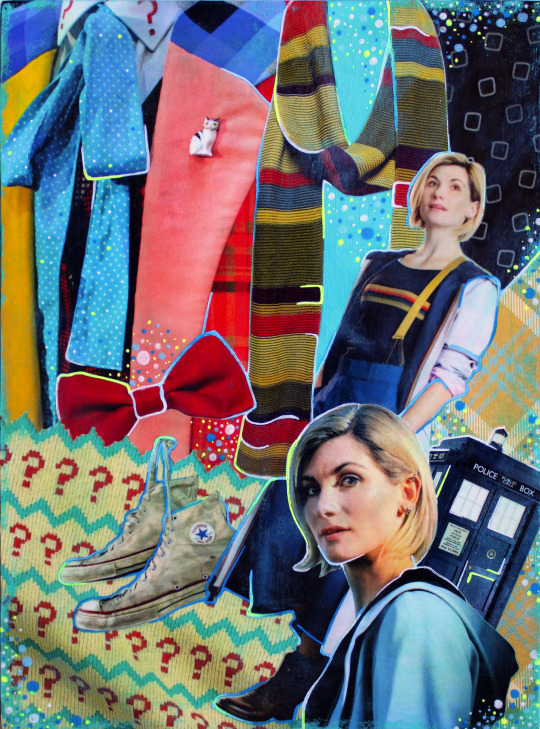





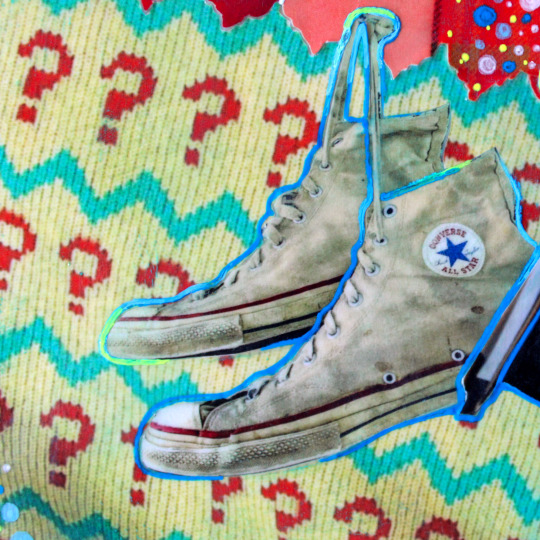
hi! here's a fun doctor who collage commission I finished the other day. they wanted the 13th doctor with some iconic looks from previous doctors!
it's on a 9x12 inch cradled wood panel. I painted the sides to match the turquoise in the vest pattern! you can't tell in these pictures (because it's so hard to photograph!) but there's a thick gloss varnish sealing the collage.
I'm open for commissions and up for whatever fandom you're into! check out my pinned post for more details. I also have my personal work over at @silasjulian if you wanna check that out too!
#13th doctor#doctor who#jodie whittaker#11th doctor#4th doctor#7th doctor#10th doctor#6th doctor#doctor who art#collage#mixed media collage#fanart collage#2024
36 notes
·
View notes
Text
Out in the desert, no one can find you... (Hex Tiles 1)
A sharp wind whistles through the desert dunes, bringing no reprieve to the travelers following the thin paths left out in the sand. Don't drink from the river — the plants that grow along its shores contain toxins that could leave a grown man coughing up blood, and chemical spills float through the current. A faraway road carries the rare drone-tank, long abandoned from any sort of human use.
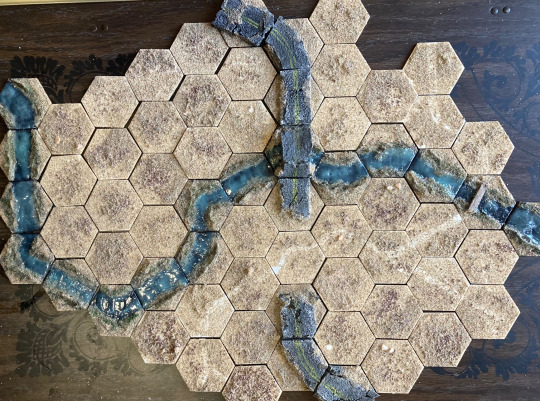
My newest hobby, to distract myself on months when the purse is a bit too tight to be buying plastic crack from Games Workshop, is to build modular hex tiles! It's super easy — I pick up a hundred of these wooden MDF tiles from Amazon for $10 (they're advertised as 2", but they're 1.75" from tip to tip, and each side is 1"), grab any spare craft supplies I have lying around, and get to work! They're super quick (this first batch of one hundred took me around a week) and they open the door to a lot of cool experimentation. A lot of this is inspired by the work of u/Marcus_Machiavelli over on Reddit, who makes these fantastic modular hive city components that I hope to someday be able to emulate.
I'm making these for two purposes, neither of which I've put in practice yet but I'm hoping to get to do at some point. They're for:
Any mass-battle games played at 6mm. This could also work for Adeptus Titanicus or the upcoming Epic reboot that Games Workshop is working on.
Tactical TTRPGs like Lancer that are played with large beings, who can operate on a 6mm scale.
Once I get some games in with them, I'm sure I'll encounter future problems and reassess how I approach them. But for now, this is what I've got!
I Hate Sand
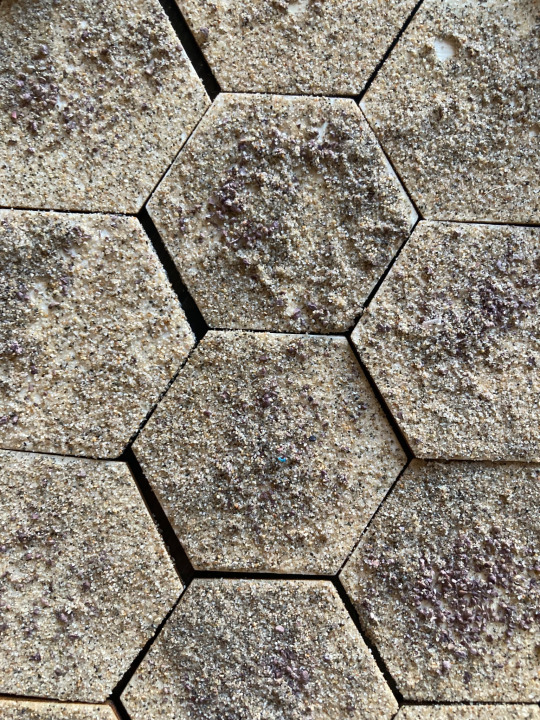
The first set of tiles I made, to serve as the backdrop for the rest of them, are these sand tiles. I chose to make this a desert (and thus make a bunch of sand tiles) because I already had some sand lying around, and because it's really cheap and easy to work with. Be careful though! Anakin was right; sand sucks. Try and pick up a finer grain than what I went with, apply the sand in a more-controlled location than I did, and secure it better than I did too. But here's how I did them:
Coat the surface of the hex with a mix of PVA glue and water.
Sprinkle on a light dusting of gravel or small rocks.
Apply a thick coat of sand on top of the gravel.
Knock off excess sand and recycle it for next time.
Spray with 1-2 layers of varnish. (I would recommend a sealant instead, but I didn't have any at the time)
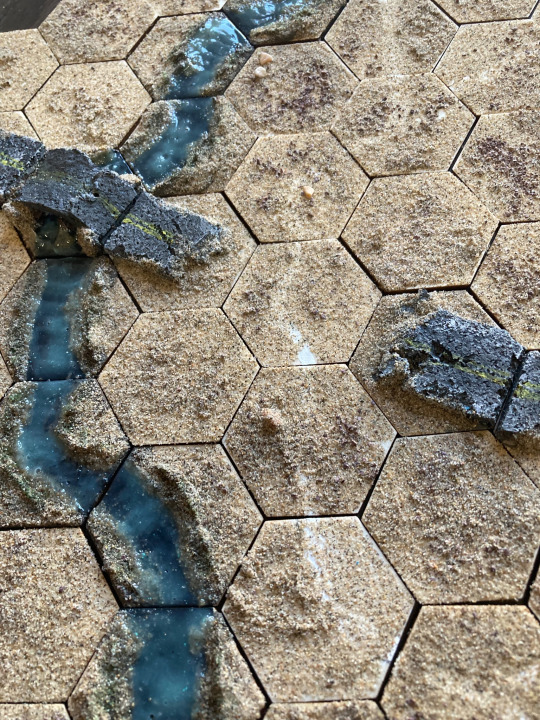
For the ones with little paths on them, I painted the path on with White before applying the gravel or sand, and it shows through well enough! The paths are unnecessary — they're a fun experiment, but I don't think I'll be making more of them in the future.
The Gurgling Creek
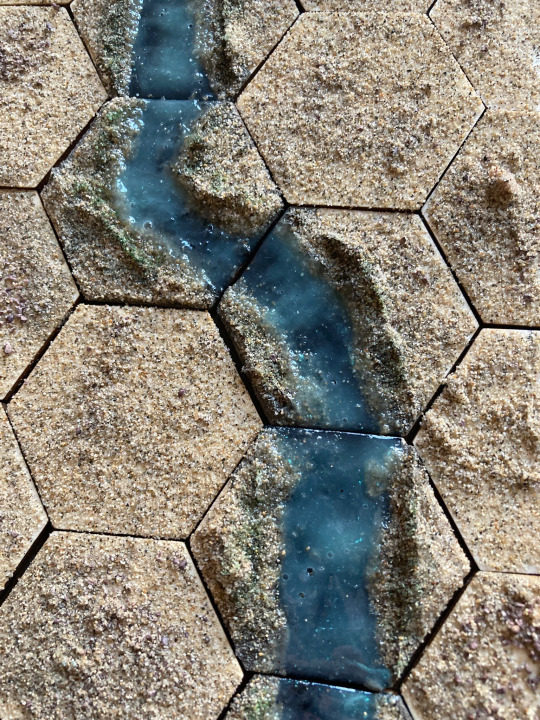
Making the river tiles was a bit more involved, but still pretty easy. The method I came up with I think looks a lot better than just painting on water, and is a lot easier to work with than resin or water effects.
Use some kind of texture gel to build up the riverbanks, trying to have them end around 1/4" on the sides of the tiles where you want your river to connect.
Paint a strip Black where you want the river to flow, running from one edge to another.
Apply sand as before, everywhere except where you painted the black. (If you're worried about fucking this up, you can swap the order)
Varnish (or use sealant) as before.
Take some gloss mod podge and mix it with a light blue paint, and apply in large goopy quantities everywhere you want water to be. Leave overnight to dry. (If you want the river to be less cloudy, apply many thin coats of mod podge instead, letting each layer dry before applying the next)
As an extra, stipple green along the edges of the water and use a dark green wash to create patches of vegetation.
The river pieces are my favorites, and I'm the most proud of them. The tiny bridge was a thin strip of balsa wood, painted white and then washed black. It turned out fine.
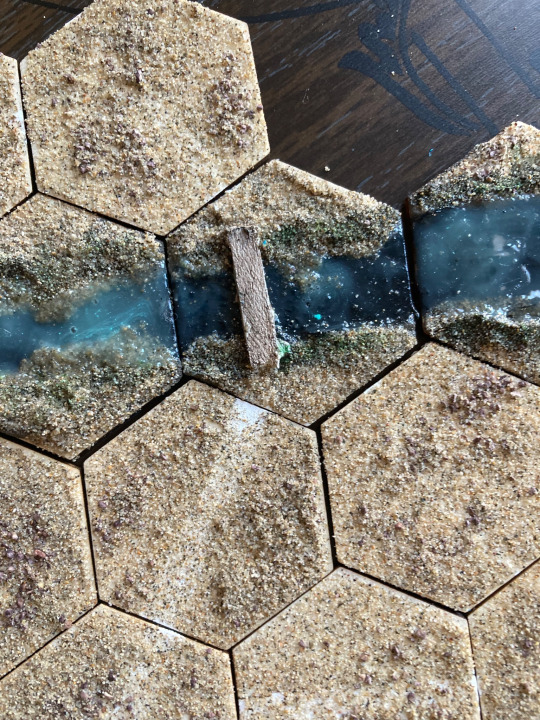
I did a solid mix of straight river pieces and curving river pieces. If I was going to do it again I'd make more curving pieces than straight river pieces, because the curving ones make more sense for how rivers work.
The Road To Nowhere

These road tiles turned out really well, perfect for a run-down highway in the middle of nowhere. Here's how I made them:
Take a piece of corkboard and cut it down to be 1.75" long and 1" wide.
Glue it on a hex with the two edges of the corkboard touching two sides of the hex.
Go at the edges with a knife, making it all worn down and busted up.
In some of these spots, I fucked up and glued the corkboard on wrong. To fix that, break off a chunk and reposition it so it'll connect correctly. This will look like a big fat crack in the middle of the road, which is perfect.
Coat in a layer of mod podge or PVA glue. Leave to dry.
Once dry, paint the cork entirely Gray.
Drybrush White onto the corkboard, focusing on the edges and exposed spots.
Paint two thin yellow lines along the middle of the road. (These are optional, but they do a lot to make the 6mm scale convincing)
Apply sand, as before, onto the ground and up the sides of the road, so it looks like the road is emerging from the sand. Maybe apply some sand in a couple spots in the cracks to make it look like the sand has gotten in there.
Varnish and/or sealant, as before.
Apply a Black wash to the road. (There's a lot of tricks here! If you want the yellow stripes to be more vibrant, you can only paint them on after the first black wash. You can also target spots of sand on the road to make it look like it's asphalt runoff, soaking black into the cracks.)
Apply a second Black wash to the road.
The bridge was a bit more complicated, and took some finicky positioning and a trip to Kung-Fu Tea.
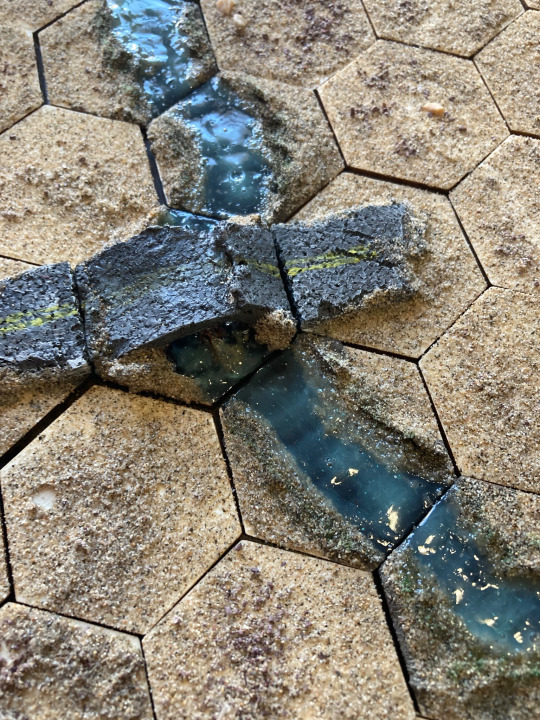
Take a boba tea straw and cut it into 1" segments, then cut them in half, gluing them to the middle of the hex as culverts.
Take corkboard and glue it over the culverts, bending it so it meets the two edges you want the bridge to run along. If it breaks, that's okay — this is a crumbling, middle-of-nowhere bridge.
Use texture gel and spare corkboard to fill in the gaps.
Use texture gel to define the steep edges of the river. Apply a little bit in between the culverts.
Do all the road steps to the road part of the bridge, and all the river steps to the river part of the bridge.
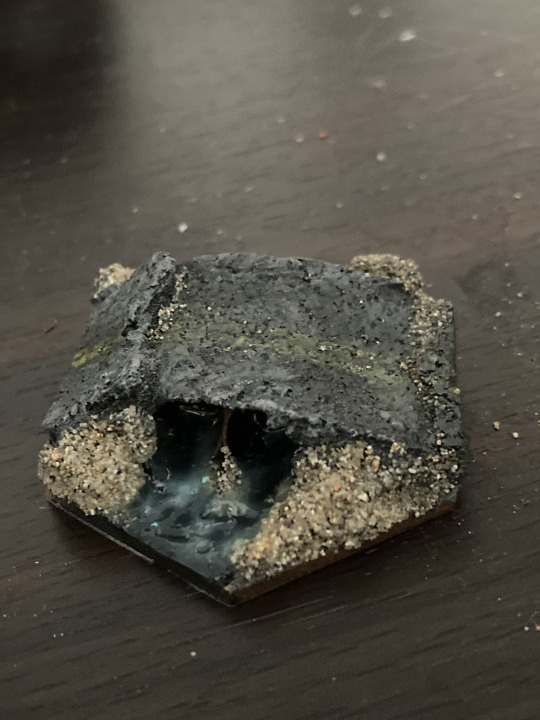
I'm exceedingly proud of the bridge hex. It turned out perfectly, and feels very emblematic of what I want this project to be like.
Why You, Too, Should Make 6mm Terrain
6mm terrain is amazing to make. Mistakes look like part of the landscape or the brain smudges them over due to the small size, and small changes look like fascinating little details. It really opens the imaginative space and I absolutely adore working at this scale. Plus I'm developing a ton of experience with various materials I've never worked with before, so I get to enjoy the triumph of carving foam or corkboard. It rules! I might even try to make a 28mm bridge after the success I had making a 6mm one.
My future plans for this project include cliffs, craters, 3D-printed shantytowns, and overpasses. But all that is for a later date — for now I'm gonna rest on my laurels, and spend the rest of the evening reconfiguring various tile combinations and cackling like a mad scientist.
169 notes
·
View notes
Text



characters belong to @ktzart
inspo photo here
acrylic, glitter, matte medium, gloss varnish on wood panel.
#im gonna start working on a backlog of my art :>#anna's glitter was fun to add tehe#artists on tumblr#painters on tumblr#painting#original character
4 notes
·
View notes
Text
I was thinking about artwork that I’ve seen.
I dunno I felt poetic
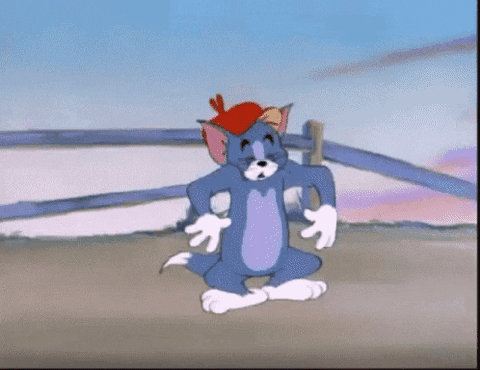
I was thinking about artwork that I’ve seen.
Drawings where the linework was so fluid it melted seamlessly into the colours, as if it were all one thing rather than layers piling one on top of the other. The shading was fantastic and gave it magic and depth. The lighting turned it into something beyond beautiful — powerful, warm, and comforting. It had background art that transported it into places of wonder. It had special decorations and detailing that would take a lifetime to uncover. It was so real it moved. It breathed. It lived.
And I wondered if people looked at art the same way I do. If people see stories in the ink blots. If they hear music in the color scheme. Do they feel warmth in the expressions, do they find wonder in the brushstrokes, do the ink marks glisten and gleam and glitter like gold?
And I wondered if people knew they were art, too. If they knew that their freckles are strategic paint splatters, made to add depth and decorum. If they saw their scars as storylines, markers of where they've been and how far they've come. How their eyes are jewels and gemstones, they sparkle and reflect the light of the sun, moon, and stars. Their smiles and frowns are strokes of a brush with precision pigment, and tears and laughter are a symphony. Can they see the extravagant and extraordinary dye used in their skin, in their lips, in their blood and tears? Have they seen the delicate weaving and braiding and crocheting of their hairs? Their joy shines like magic through their pores, their fingers are tools and their voices are instruments. Their names are reflections of their person, the title of their artwork. Do they know they are masterpieces?
And I wondered if people…
If one person would ever look at me like that. If someone would see my lighting, my shading, my composition and negative space. If my lineart was seamless, if my colours clashed or blended in a lovely way, if my details drew them in, if I was intricate or creative or magic. Could they notice how I sway when I get tired, like I'm slow-dancing to a lullaby, or how I click my tongue and hum when I'm bored… How my feet turn in, how sometimes I stumble on my R's, how my eyes resemble sunflowers… My freckles go down like connect-the-dots in a constellation on my arms, my nails are nibbled down, my hands are covered in ink, my ears covered in headphones secured within a song… My shoes are decorated with charms, my jeans are old, ripped and cut-off at the knees, my sweaters are warm and oversized, I hide inside them like a picture in a frame, snug and silly, flapping my hands underneath the long sleeves. Do they hear how I sing constantly, how I talk in every accent I can get my hands on, see how I add extra U's to words like “colour” or “honour” or “favour”, how I talk to myself in the woods where I write my stories, how I still believe in magic like Ents and Faes and the Loch Ness monster and miracles... could they see all my quirks and flaws and what very few redeeming qualities I find in myself, and could they see them all as paint? As pencil marks? As ink and dye? As gloss and varnish? Could my rambles sound like music? Could my smile be glitter? Could my voice be winds and strings and brass? Could anyone look at me and see the artwork?
But mostly I wondered if I would ever be able to look at myself like how I look at the artwork.
#poem#artwork#you are a masterpiece#you are beautiful#you are loved#i was feeling poetic#writing#tumblr writers#magical#artist on tumblr#artist stuff#phoebepheebsphibs#phoebepheebsphibs pheeling phoetic#phoebepheebsphibs feeling poetic
14 notes
·
View notes
Text



I originally bought this to replace a beagal picture that's like a family heir loom, idk its been with the family for generations. i'm going to put images of bagel's over them. or something. anyways i was forbidden, to put it up so I painted it and offered it to a friend.
features glow in the dark eyes[ the main ones] and glow in the dark fangs. sealed in a satin varnish, high gloss only for the inner mouth teeth and eyes. mounted it to a piece of wood. not seen
because I was at the end of my rope with this project. documenting progress tends to fall off the list of things to do, the more frustrated I get with it.
pretty sure I'm like super burned out from art right now.
2 notes
·
View notes
Text
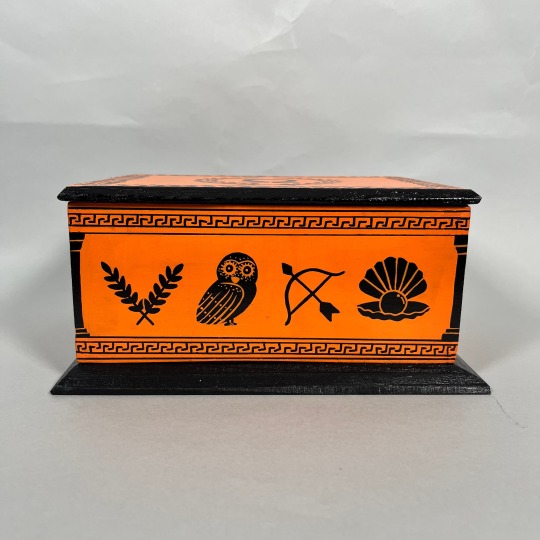
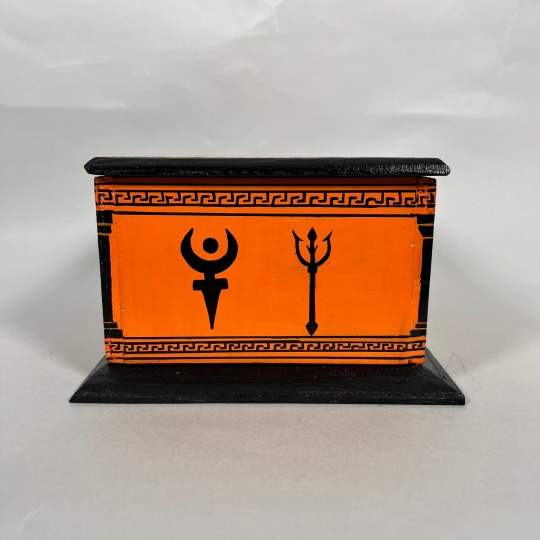
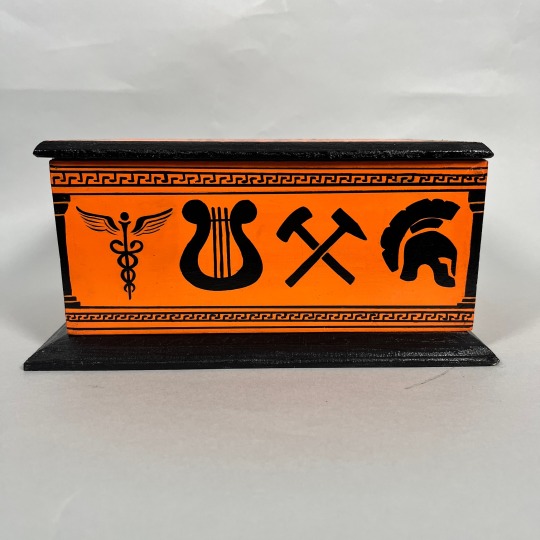
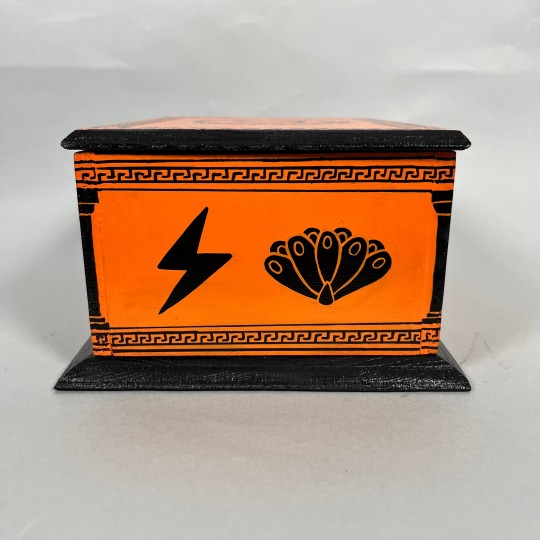
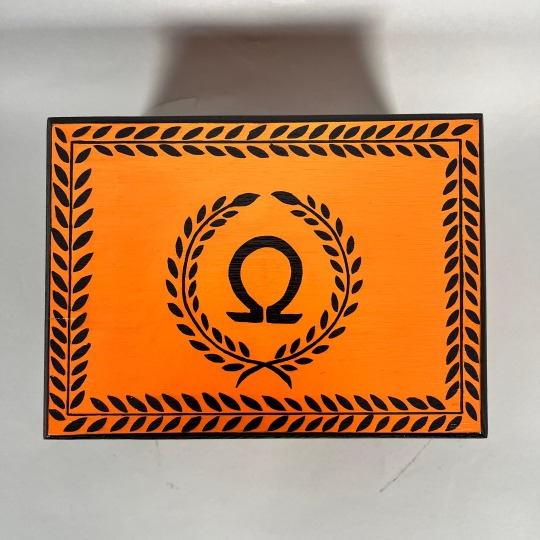
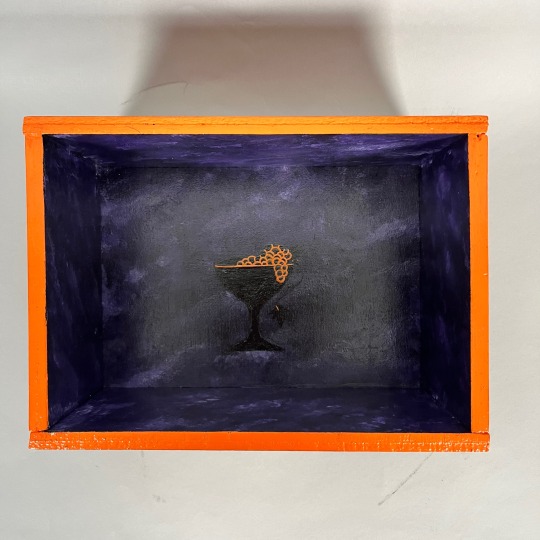
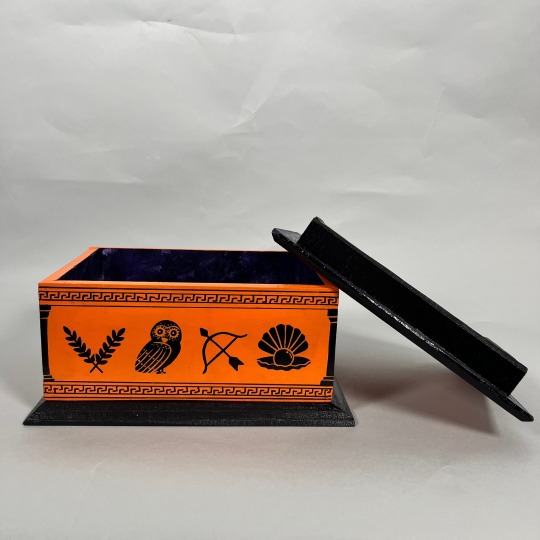
“Pandora’s Box”
10” x 4.63” x 7.5”
Multimedia: Scrap wood, interior wall paint, acrylic paint, posca paint pens, high gloss varnish, glow in the dark pigment mixed in acrylic paint
-
-
After roughly a month, Pandora’s box is complete! Not depicted in the images is the little wax seal on the inside of the lid that has my logo on it! Also it glows if you hold a black light to the inside of the box 😈
#art#artist#epic the musical#greek mythology#tagamemnon#pandoras box myth#pandoras box#wood sculpture#artists on tumblr#my art tag
19 notes
·
View notes
Text
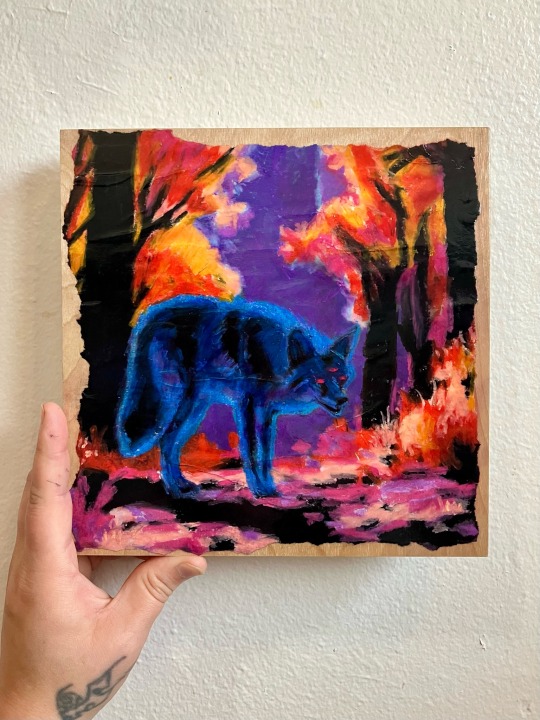
5 notes
·
View notes
Photo

Old Tanned Leather Vegetable Tanned Leather - Tanned Leather - Vegetable tanning Leather tanned with vegetable tanning agents . Quebracho wood, mimosa bark, oak wood etc. Tanning process: 20-30 months. Per hide approx. 30 kg bark or 20 kg fruit or 90 kg oak wood. Aniline leather Leather dyed with aniline dyes that reveal the natural texture of the hide material. It has a waxy feel and a matt surface. Very expensive leather. The surface is usually not oversprayed (without pigment finish) or corrected. Antique leather Antique leather is created by a special dyeing technique of nappa leather, which gives the leather an old, antique appearance. The leather has been given an old-style appearance by pressing or wiping (wipe leather, Chesterfield leather). It is usually two-coloured. Blank leather Natural or dyed vegetable dyed cowhide. It is moderately greased and sometimes waxed. Boxcalf Boxcalfis a full chrome tanned, also crimped, smooth, soft calfskin for bags and shoes. Traditionally black in England. Buffalo leather Leather made from buffalo hides, usually slightly buffed on the grain side. Chamois leather Chamois leather is a particularly soft, fat-tanned (tanning) chamois or goat leather with good absorbency. Elk leather - Elk leather As a rule, elk leather is chamois, i.e. tanned leather for trousers, jackets and costumes. Damage caused by the botfly and also thorn cracks are typical and are regarded as a sign of authenticity. Chamois leather - Wash leather This refers to chamois-tanned split leather, mostly from sheep. Such leathers are usually sold as wash leather. Originally, this type of leather was used almost exclusively for cleaning windows. Today it is partly used as clothing leather. Smooth leather Smooth leather is the term used for all types of leather whose grain side (upper side) is not sanded to the outside. Deerskin Deer skin is primarily used to make trouser leather. It is tanned in a chamois (tran) process and can be recognised by its yellow inner side. As far as light skins are concerned, they are also made into jackets and costumes. Elk also belong to the deer family. The hides of these animals always make suede. Hunting leather Hunting leather is another name for suede. Russia leather Russia leather is a soft and waterproof, dyed and tanned calf or cow leather. In the past, Russia leather was impregnated with birch tar oil, which also gave it its well-known scent. Crumpled patent leather Crumpled patent leather is a nappa leather that has been varnished on the surface or coated with a thin synthetic film and then crimped. Crocodile leather Only the belly skin and hides of younger crocodiles are processed into leather. Crocodile leather is usually used to make precious shoes and handbags. Patent leather Patent leather is a high-gloss leather that has been varnished on the surface or covered with a shiny, mirror-smooth film. Nappa leather Nappa leather is the general term for leather made from the hides of various animals, which is processed with the hair side facing outwards, i.e. on the grain side. Nappa leather is usually a non-slip, elastic and full-grain leather. The grain side is finished with opaque dyes and given a matt sheen by plushing. Full-grain, usually chrome-tanned, dyed smooth leather with pigment finish. Vegetable-dyed nappa leathers are usually not dyed through. These leathers are natural brown on the reverse side. Nubuck leather A firm calf or cow leather with a velvety surface, sanded on the grain side. Parchment Parchment leather is the translucent, dried raw hides that are used untanned and merely oiled as book covers, lampshades and drum skins. It is made from sheep, goat or calf skins as well as from pig, buffalo or donkey skins. The pelt is dried without any tanning. The material is oiled, greased and smoothed during the manufacturing process. Pull-up leather - Pullup leather Cowhide that retains its character through special processing. Through use (bending, stretching, abrasion, etc.), strong signs of wear or patina quickly form. Pull-UP is an aniline-dyed, soft cowhide nubuck leather with a fat handle Rough leather - Rough leather Rough leather is a collective term for leather with a more or less rough surface. Chamois leather Chamois leather is leather produced by oxidation of Tran or fish oil in sheepskins or lambskins whose grain has been split off or shed. It is either purely tran tanned (genuine chamois) or formaldehyde pre-tanned with a tran retanning (neo-sawn). In Germany, the term chamois leather covers tanned suede from sheep, lamb, deer, roe deer, chamois, goat, kid and reindeer skins as well as from cow splits. France and the USA restrict the term chamois leather to the flesh split of sheepskins tanned only with Tran. Snakeskin Snake skins are usually used in the bag and shoe industry. Pigskin - Porcleder A distinction is made between the leather of domestic pigs, commonly called pork, and that of wild boar, whose most important representative for the leather industry is peccary. The European domestic pig in particular produces a leather that is extremely rich in fat. Nevertheless, it is usually quite durable. Domestic pigs are only slightly hairy. The characteristic grain is determined not only by the hair pores but also by the bristly structure of the surface tissue. The leather of the peccary is mainly used to make high-quality glove leather. Semi-aniline leather Leather which is aniline-dyed using small amounts of pigment dyes. The natural grain pattern should not be concealed. Split leather - grain split - core split - flesh split If a hide or skin is split into several layers over the entire surface, this process is called splitting. Often thicker leathers - especially from cattle - are split. The layers obtained in this way are called grain split (outer split), flesh split (lower split) and, in the case of heavier hides, core split (middle split or intermediate split) may also occur. In the case of leathers made from meat split or middle split, the word split must be part of the name, e.g. cow split, pig split etc., as this split leather is usually not as valuable and of such high quality as the grain split. Wash Leather Suede tanned leather and washable leather is called wash leather. Wash leather articles can be washed with leather detergents. The detergents are dissolved in lukewarm water. Suede Leather Suede is the collective term for leather from animals that live in the wild (e.g. deer, elk, antelope, chamois, etc.). Goatsuede Pure chrome-tanned goatsuede with a velvet-like cut on the flesh side. Source link
0 notes
Text


I had a ton of fun making this set of mixed media phantom of the opera coasters for @musingsofauniversedisturber! ♥️
they’re on little 4x4 inch wood panels that are 3/8th of an inch thick. they’re sealed with gloss varnish and have little silicone pads on the bottom!
16 notes
·
View notes
Photo

Old Tanned Leather Vegetable Tanned Leather - Tanned Leather - Vegetable tanning Leather tanned with vegetable tanning agents . Quebracho wood, mimosa bark, oak wood etc. Tanning process: 20-30 months. Per hide approx. 30 kg bark or 20 kg fruit or 90 kg oak wood. Aniline leather Leather dyed with aniline dyes that reveal the natural texture of the hide material. It has a waxy feel and a matt surface. Very expensive leather. The surface is usually not oversprayed (without pigment finish) or corrected. Antique leather Antique leather is created by a special dyeing technique of nappa leather, which gives the leather an old, antique appearance. The leather has been given an old-style appearance by pressing or wiping (wipe leather, Chesterfield leather). It is usually two-coloured. Blank leather Natural or dyed vegetable dyed cowhide. It is moderately greased and sometimes waxed. Boxcalf Boxcalfis a full chrome tanned, also crimped, smooth, soft calfskin for bags and shoes. Traditionally black in England. Buffalo leather Leather made from buffalo hides, usually slightly buffed on the grain side. Chamois leather Chamois leather is a particularly soft, fat-tanned (tanning) chamois or goat leather with good absorbency. Elk leather - Elk leather As a rule, elk leather is chamois, i.e. tanned leather for trousers, jackets and costumes. Damage caused by the botfly and also thorn cracks are typical and are regarded as a sign of authenticity. Chamois leather - Wash leather This refers to chamois-tanned split leather, mostly from sheep. Such leathers are usually sold as wash leather. Originally, this type of leather was used almost exclusively for cleaning windows. Today it is partly used as clothing leather. Smooth leather Smooth leather is the term used for all types of leather whose grain side (upper side) is not sanded to the outside. Deerskin Deer skin is primarily used to make trouser leather. It is tanned in a chamois (tran) process and can be recognised by its yellow inner side. As far as light skins are concerned, they are also made into jackets and costumes. Elk also belong to the deer family. The hides of these animals always make suede. Hunting leather Hunting leather is another name for suede. Russia leather Russia leather is a soft and waterproof, dyed and tanned calf or cow leather. In the past, Russia leather was impregnated with birch tar oil, which also gave it its well-known scent. Crumpled patent leather Crumpled patent leather is a nappa leather that has been varnished on the surface or coated with a thin synthetic film and then crimped. Crocodile leather Only the belly skin and hides of younger crocodiles are processed into leather. Crocodile leather is usually used to make precious shoes and handbags. Patent leather Patent leather is a high-gloss leather that has been varnished on the surface or covered with a shiny, mirror-smooth film. Nappa leather Nappa leather is the general term for leather made from the hides of various animals, which is processed with the hair side facing outwards, i.e. on the grain side. Nappa leather is usually a non-slip, elastic and full-grain leather. The grain side is finished with opaque dyes and given a matt sheen by plushing. Full-grain, usually chrome-tanned, dyed smooth leather with pigment finish. Vegetable-dyed nappa leathers are usually not dyed through. These leathers are natural brown on the reverse side. Nubuck leather A firm calf or cow leather with a velvety surface, sanded on the grain side. Parchment Parchment leather is the translucent, dried raw hides that are used untanned and merely oiled as book covers, lampshades and drum skins. It is made from sheep, goat or calf skins as well as from pig, buffalo or donkey skins. The pelt is dried without any tanning. The material is oiled, greased and smoothed during the manufacturing process. Pull-up leather - Pullup leather Cowhide that retains its character through special processing. Through use (bending, stretching, abrasion, etc.), strong signs of wear or patina quickly form. Pull-UP is an aniline-dyed, soft cowhide nubuck leather with a fat handle Rough leather - Rough leather Rough leather is a collective term for leather with a more or less rough surface. Chamois leather Chamois leather is leather produced by oxidation of Tran or fish oil in sheepskins or lambskins whose grain has been split off or shed. It is either purely tran tanned (genuine chamois) or formaldehyde pre-tanned with a tran retanning (neo-sawn). In Germany, the term chamois leather covers tanned suede from sheep, lamb, deer, roe deer, chamois, goat, kid and reindeer skins as well as from cow splits. France and the USA restrict the term chamois leather to the flesh split of sheepskins tanned only with Tran. Snakeskin Snake skins are usually used in the bag and shoe industry. Pigskin - Porcleder A distinction is made between the leather of domestic pigs, commonly called pork, and that of wild boar, whose most important representative for the leather industry is peccary. The European domestic pig in particular produces a leather that is extremely rich in fat. Nevertheless, it is usually quite durable. Domestic pigs are only slightly hairy. The characteristic grain is determined not only by the hair pores but also by the bristly structure of the surface tissue. The leather of the peccary is mainly used to make high-quality glove leather. Semi-aniline leather Leather which is aniline-dyed using small amounts of pigment dyes. The natural grain pattern should not be concealed. Split leather - grain split - core split - flesh split If a hide or skin is split into several layers over the entire surface, this process is called splitting. Often thicker leathers - especially from cattle - are split. The layers obtained in this way are called grain split (outer split), flesh split (lower split) and, in the case of heavier hides, core split (middle split or intermediate split) may also occur. In the case of leathers made from meat split or middle split, the word split must be part of the name, e.g. cow split, pig split etc., as this split leather is usually not as valuable and of such high quality as the grain split. Wash Leather Suede tanned leather and washable leather is called wash leather. Wash leather articles can be washed with leather detergents. The detergents are dissolved in lukewarm water. Suede Leather Suede is the collective term for leather from animals that live in the wild (e.g. deer, elk, antelope, chamois, etc.). Goatsuede Pure chrome-tanned goatsuede with a velvet-like cut on the flesh side. Source link
0 notes
Text


Concept art + process! Individual stages and commentary under the cut because I love 2 yap about my process
Prefacing this by saying that this isn't intended as a tutorial — I hope to make a proper how-to someday, but until then you're free to contact me if there's a particular part of my process you'd like to know more about :]

Plasticine base sculpt
Most of my masks and larger sculptures start life as a clay base, over which I then layer the papier mâché. My recent ones use a water-soluble plasticine, which allows me to apply the paper directly to the base without having to prevent the clay from drying out or adhering to the paper.


Papier mâché strips
I begin by layering tissue paper brushed with wallpaper paste over the sculpt to capture every nook and cranny, followed by a layer of newspaper strips for structure and to give the paper pulp something to adhere to.


Papier mâché pulp
The main structure of the mask is made out of papier mâché pulp — essentially a thick smoothie of soaked blended newspaper and/or egg carton and a whole lot of wallpaper paste and wood glue (use solvent-free stuff!!). This mask is all egg carton, which is easier to work with as the fibers are shorter to begin with. My previous stuff is all newspaper, though! It works just as well but requires a bit more processing to get a smooth result.
Even though this isn't a tutorial, I feel the need to stress that when working with paper pulp, DO NOT dispose of the leftover water directly into your plumbing — it is still full of miniscule paper fibers that WILL clog your pipes Big Time. Either let the water evaporate, or strain it several times through a tightly woven fabric.



Sanding, clay details and lining
After cleaning off the plasticine residue, I brush down the inside of the mask with a few layers of Mod Podge for stability, then trim it and sand the outside as smooth as I can. I use air-dry paper clay to fill any dimples and to sculpt any details too intricate to be done in pulp.
My previous masks are just plain paper on the inside, but I decided to give this one a nice meaty lining with some decoupage :)





Painting
I've been experimenting with some new methods for creating depth and texture in skin — my older masks have an even-colored base blushed with makeup pigments, which tends to look a bit flat. For this one, I instead tried to think more about the layers and properties of real flesh, working my way up from a red underpainting. I use acrylic paints mixed with different ratios of water and matte gel medium. I've never used the gel stuff before, but frankly I didn't find it made much of a difference, aside from making my brush strokes more visible. Maybe I should have gone for the glossy stuff instead? :/



Varnish, mesh and fastening
Once the paint is dry, I give the mask a few layers of matte liquid varnish for protection, then a light brushing of gloss for a realistic sheen.
Finally, I install the eye mesh and fastening! The mask stays on using a small wire hook that allows me to hang it on a fake, clip-on septum piercing. It's very lightweight, so this doesn't hurt unless I get it caught on something (Do Not use a real piercing as an anchor). I hit the inside with another layer of decoupage to make it look a bit tidier, then several more coats of Mod Podge to protect it from the moisture of my breath.
Annnd that's it, I think! Thanks for reading :]
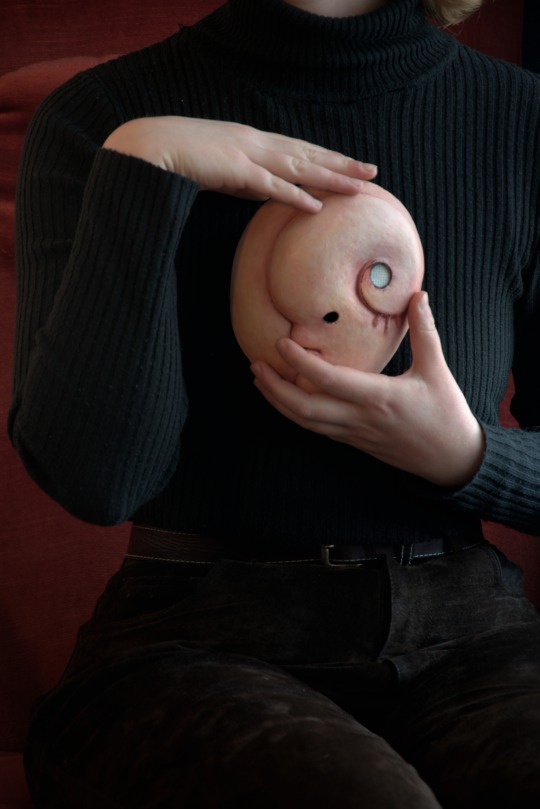
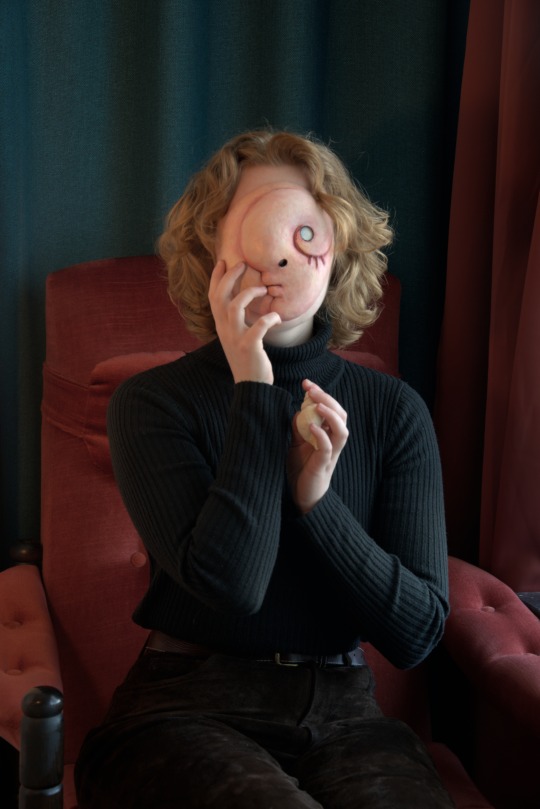
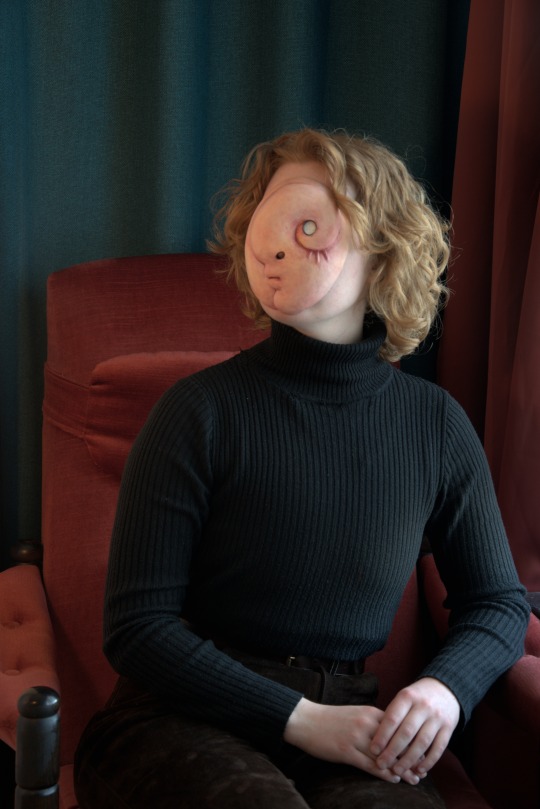
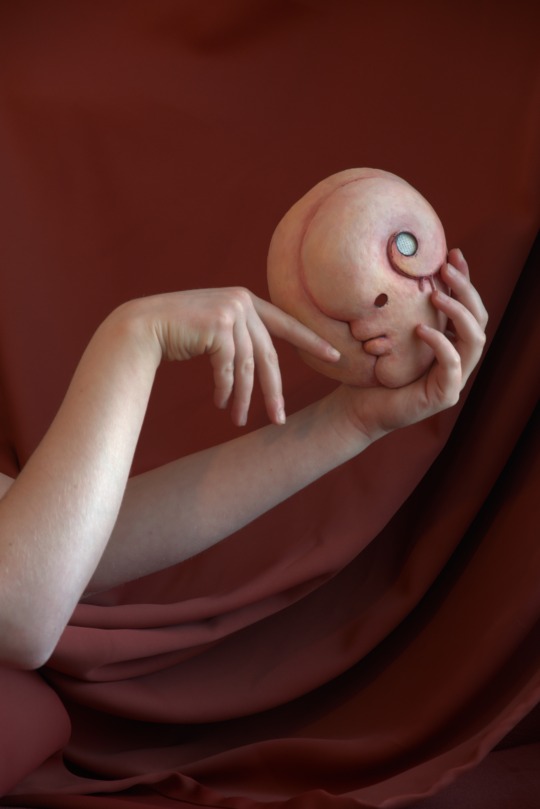
@ (2025)
Papier-mâché pulp, air-dry clay, mesh, acrylics
Been experimenting with strapless masks and new ways of mimicking flesh.
2K notes
·
View notes
Photo

Old Tanned Leather Vegetable Tanned Leather - Tanned Leather - Vegetable tanning Leather tanned with vegetable tanning agents . Quebracho wood, mimosa bark, oak wood etc. Tanning process: 20-30 months. Per hide approx. 30 kg bark or 20 kg fruit or 90 kg oak wood. Aniline leather Leather dyed with aniline dyes that reveal the natural texture of the hide material. It has a waxy feel and a matt surface. Very expensive leather. The surface is usually not oversprayed (without pigment finish) or corrected. Antique leather Antique leather is created by a special dyeing technique of nappa leather, which gives the leather an old, antique appearance. The leather has been given an old-style appearance by pressing or wiping (wipe leather, Chesterfield leather). It is usually two-coloured. Blank leather Natural or dyed vegetable dyed cowhide. It is moderately greased and sometimes waxed. Boxcalf Boxcalfis a full chrome tanned, also crimped, smooth, soft calfskin for bags and shoes. Traditionally black in England. Buffalo leather Leather made from buffalo hides, usually slightly buffed on the grain side. Chamois leather Chamois leather is a particularly soft, fat-tanned (tanning) chamois or goat leather with good absorbency. Elk leather - Elk leather As a rule, elk leather is chamois, i.e. tanned leather for trousers, jackets and costumes. Damage caused by the botfly and also thorn cracks are typical and are regarded as a sign of authenticity. Chamois leather - Wash leather This refers to chamois-tanned split leather, mostly from sheep. Such leathers are usually sold as wash leather. Originally, this type of leather was used almost exclusively for cleaning windows. Today it is partly used as clothing leather. Smooth leather Smooth leather is the term used for all types of leather whose grain side (upper side) is not sanded to the outside. Deerskin Deer skin is primarily used to make trouser leather. It is tanned in a chamois (tran) process and can be recognised by its yellow inner side. As far as light skins are concerned, they are also made into jackets and costumes. Elk also belong to the deer family. The hides of these animals always make suede. Hunting leather Hunting leather is another name for suede. Russia leather Russia leather is a soft and waterproof, dyed and tanned calf or cow leather. In the past, Russia leather was impregnated with birch tar oil, which also gave it its well-known scent. Crumpled patent leather Crumpled patent leather is a nappa leather that has been varnished on the surface or coated with a thin synthetic film and then crimped. Crocodile leather Only the belly skin and hides of younger crocodiles are processed into leather. Crocodile leather is usually used to make precious shoes and handbags. Patent leather Patent leather is a high-gloss leather that has been varnished on the surface or covered with a shiny, mirror-smooth film. Nappa leather Nappa leather is the general term for leather made from the hides of various animals, which is processed with the hair side facing outwards, i.e. on the grain side. Nappa leather is usually a non-slip, elastic and full-grain leather. The grain side is finished with opaque dyes and given a matt sheen by plushing. Full-grain, usually chrome-tanned, dyed smooth leather with pigment finish. Vegetable-dyed nappa leathers are usually not dyed through. These leathers are natural brown on the reverse side. Nubuck leather A firm calf or cow leather with a velvety surface, sanded on the grain side. Parchment Parchment leather is the translucent, dried raw hides that are used untanned and merely oiled as book covers, lampshades and drum skins. It is made from sheep, goat or calf skins as well as from pig, buffalo or donkey skins. The pelt is dried without any tanning. The material is oiled, greased and smoothed during the manufacturing process. Pull-up leather - Pullup leather Cowhide that retains its character through special processing. Through use (bending, stretching, abrasion, etc.), strong signs of wear or patina quickly form. Pull-UP is an aniline-dyed, soft cowhide nubuck leather with a fat handle Rough leather - Rough leather Rough leather is a collective term for leather with a more or less rough surface. Chamois leather Chamois leather is leather produced by oxidation of Tran or fish oil in sheepskins or lambskins whose grain has been split off or shed. It is either purely tran tanned (genuine chamois) or formaldehyde pre-tanned with a tran retanning (neo-sawn). In Germany, the term chamois leather covers tanned suede from sheep, lamb, deer, roe deer, chamois, goat, kid and reindeer skins as well as from cow splits. France and the USA restrict the term chamois leather to the flesh split of sheepskins tanned only with Tran. Snakeskin Snake skins are usually used in the bag and shoe industry. Pigskin - Porcleder A distinction is made between the leather of domestic pigs, commonly called pork, and that of wild boar, whose most important representative for the leather industry is peccary. The European domestic pig in particular produces a leather that is extremely rich in fat. Nevertheless, it is usually quite durable. Domestic pigs are only slightly hairy. The characteristic grain is determined not only by the hair pores but also by the bristly structure of the surface tissue. The leather of the peccary is mainly used to make high-quality glove leather. Semi-aniline leather Leather which is aniline-dyed using small amounts of pigment dyes. The natural grain pattern should not be concealed. Split leather - grain split - core split - flesh split If a hide or skin is split into several layers over the entire surface, this process is called splitting. Often thicker leathers - especially from cattle - are split. The layers obtained in this way are called grain split (outer split), flesh split (lower split) and, in the case of heavier hides, core split (middle split or intermediate split) may also occur. In the case of leathers made from meat split or middle split, the word split must be part of the name, e.g. cow split, pig split etc., as this split leather is usually not as valuable and of such high quality as the grain split. Wash Leather Suede tanned leather and washable leather is called wash leather. Wash leather articles can be washed with leather detergents. The detergents are dissolved in lukewarm water. Suede Leather Suede is the collective term for leather from animals that live in the wild (e.g. deer, elk, antelope, chamois, etc.). Goatsuede Pure chrome-tanned goatsuede with a velvet-like cut on the flesh side. Source link
0 notes
Photo

Old Tanned Leather Vegetable Tanned Leather - Tanned Leather - Vegetable tanning Leather tanned with vegetable tanning agents . Quebracho wood, mimosa bark, oak wood etc. Tanning process: 20-30 months. Per hide approx. 30 kg bark or 20 kg fruit or 90 kg oak wood. Aniline leather Leather dyed with aniline dyes that reveal the natural texture of the hide material. It has a waxy feel and a matt surface. Very expensive leather. The surface is usually not oversprayed (without pigment finish) or corrected. Antique leather Antique leather is created by a special dyeing technique of nappa leather, which gives the leather an old, antique appearance. The leather has been given an old-style appearance by pressing or wiping (wipe leather, Chesterfield leather). It is usually two-coloured. Blank leather Natural or dyed vegetable dyed cowhide. It is moderately greased and sometimes waxed. Boxcalf Boxcalfis a full chrome tanned, also crimped, smooth, soft calfskin for bags and shoes. Traditionally black in England. Buffalo leather Leather made from buffalo hides, usually slightly buffed on the grain side. Chamois leather Chamois leather is a particularly soft, fat-tanned (tanning) chamois or goat leather with good absorbency. Elk leather - Elk leather As a rule, elk leather is chamois, i.e. tanned leather for trousers, jackets and costumes. Damage caused by the botfly and also thorn cracks are typical and are regarded as a sign of authenticity. Chamois leather - Wash leather This refers to chamois-tanned split leather, mostly from sheep. Such leathers are usually sold as wash leather. Originally, this type of leather was used almost exclusively for cleaning windows. Today it is partly used as clothing leather. Smooth leather Smooth leather is the term used for all types of leather whose grain side (upper side) is not sanded to the outside. Deerskin Deer skin is primarily used to make trouser leather. It is tanned in a chamois (tran) process and can be recognised by its yellow inner side. As far as light skins are concerned, they are also made into jackets and costumes. Elk also belong to the deer family. The hides of these animals always make suede. Hunting leather Hunting leather is another name for suede. Russia leather Russia leather is a soft and waterproof, dyed and tanned calf or cow leather. In the past, Russia leather was impregnated with birch tar oil, which also gave it its well-known scent. Crumpled patent leather Crumpled patent leather is a nappa leather that has been varnished on the surface or coated with a thin synthetic film and then crimped. Crocodile leather Only the belly skin and hides of younger crocodiles are processed into leather. Crocodile leather is usually used to make precious shoes and handbags. Patent leather Patent leather is a high-gloss leather that has been varnished on the surface or covered with a shiny, mirror-smooth film. Nappa leather Nappa leather is the general term for leather made from the hides of various animals, which is processed with the hair side facing outwards, i.e. on the grain side. Nappa leather is usually a non-slip, elastic and full-grain leather. The grain side is finished with opaque dyes and given a matt sheen by plushing. Full-grain, usually chrome-tanned, dyed smooth leather with pigment finish. Vegetable-dyed nappa leathers are usually not dyed through. These leathers are natural brown on the reverse side. Nubuck leather A firm calf or cow leather with a velvety surface, sanded on the grain side. Parchment Parchment leather is the translucent, dried raw hides that are used untanned and merely oiled as book covers, lampshades and drum skins. It is made from sheep, goat or calf skins as well as from pig, buffalo or donkey skins. The pelt is dried without any tanning. The material is oiled, greased and smoothed during the manufacturing process. Pull-up leather - Pullup leather Cowhide that retains its character through special processing. Through use (bending, stretching, abrasion, etc.), strong signs of wear or patina quickly form. Pull-UP is an aniline-dyed, soft cowhide nubuck leather with a fat handle Rough leather - Rough leather Rough leather is a collective term for leather with a more or less rough surface. Chamois leather Chamois leather is leather produced by oxidation of Tran or fish oil in sheepskins or lambskins whose grain has been split off or shed. It is either purely tran tanned (genuine chamois) or formaldehyde pre-tanned with a tran retanning (neo-sawn). In Germany, the term chamois leather covers tanned suede from sheep, lamb, deer, roe deer, chamois, goat, kid and reindeer skins as well as from cow splits. France and the USA restrict the term chamois leather to the flesh split of sheepskins tanned only with Tran. Snakeskin Snake skins are usually used in the bag and shoe industry. Pigskin - Porcleder A distinction is made between the leather of domestic pigs, commonly called pork, and that of wild boar, whose most important representative for the leather industry is peccary. The European domestic pig in particular produces a leather that is extremely rich in fat. Nevertheless, it is usually quite durable. Domestic pigs are only slightly hairy. The characteristic grain is determined not only by the hair pores but also by the bristly structure of the surface tissue. The leather of the peccary is mainly used to make high-quality glove leather. Semi-aniline leather Leather which is aniline-dyed using small amounts of pigment dyes. The natural grain pattern should not be concealed. Split leather - grain split - core split - flesh split If a hide or skin is split into several layers over the entire surface, this process is called splitting. Often thicker leathers - especially from cattle - are split. The layers obtained in this way are called grain split (outer split), flesh split (lower split) and, in the case of heavier hides, core split (middle split or intermediate split) may also occur. In the case of leathers made from meat split or middle split, the word split must be part of the name, e.g. cow split, pig split etc., as this split leather is usually not as valuable and of such high quality as the grain split. Wash Leather Suede tanned leather and washable leather is called wash leather. Wash leather articles can be washed with leather detergents. The detergents are dissolved in lukewarm water. Suede Leather Suede is the collective term for leather from animals that live in the wild (e.g. deer, elk, antelope, chamois, etc.). Goatsuede Pure chrome-tanned goatsuede with a velvet-like cut on the flesh side. Source link
0 notes